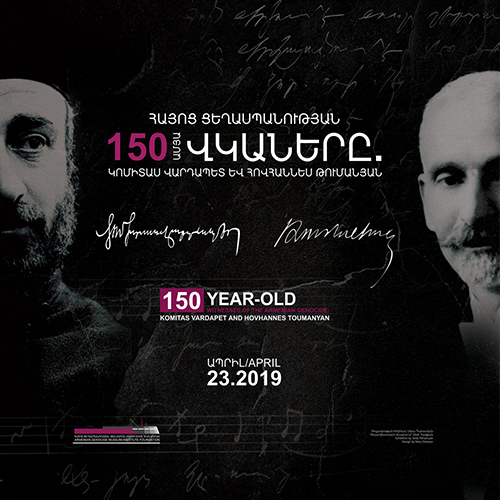
On April 23, 2019, at 12:00 PM, at the temporary exhibitions hall of the Armenian Genocide Museum-Institute Foundation the opening of the new exhibition
“150 YEAR-OLD WITNESSES OF THE ARMENIAN GENOCIDE: KOMITAS VARDAPET AND HOVANNES TUMANYAN” will take place.
The exhibition is dedicated to the 150th anniversaries of two great Armenian intellectuals - Komitas Vardapet and Hovannes Toumanyan. The aim of the exhibition is to publicize their ties with the history of the Armenian Genocide. The exhibition has two main directions: on one hand friendly and creative relationship of the two geniuses is illustrated, and on the other hand, the impact of the Armenian Genocide and its tragic consequences on them.
The bilingual (Armenian, English) exhibition consisting of eight panels includes original materials from the collections of the Armenian Genocide Museum-Institute, as well as materials and photos from various archives and museums in Armenia. For the first time an excerpt from video testimony of Aghavni Mkrtchyan, a genocide survivor from Bitlis, on the relief work of Hovhannes Toumanyan in 1915 in Echmadzin among the Armenian refugees will be shown. A wead-beads of a unique importance made by Varteres Atanesyan, one of the Armenian intellectuals exiled to Chankere on April 11/24, 1915, is presented among the original materials. The wead-beads is made on the way to Chankere. The names of 99 exiled Armenian intellectuals are engraved on the beads: the name of Komitas Vardapet is carved on the first grain.
The exhibition will be accompanied by Komitas' unfinished opera music based on Toumanyan’s “Anoush” opera, performed by Araks Mansouryan. Several sketches of the Armenian renowned painter Sargis Mouradyan from his "Komitas" series will also be exhibited.
After the exhibition opening tree planting ceremony will take place in the Memory Alley, in memory of the 150th anniversaries of Hovhannes Toumanyan and Komitas Vardapet.
The exhibition will be open until August 30, 2019, entrance is free.
“The exhibition is unique and very teaching. It is being versatile in covering the connections of the two geniuses, and in the same time their connection with the Armenian Genocide,” - mentions Seda Parsamyan, the author of the exhibition, the head of the Exhibition Department of Armenian Genocide Museum-Institute Foundation.





